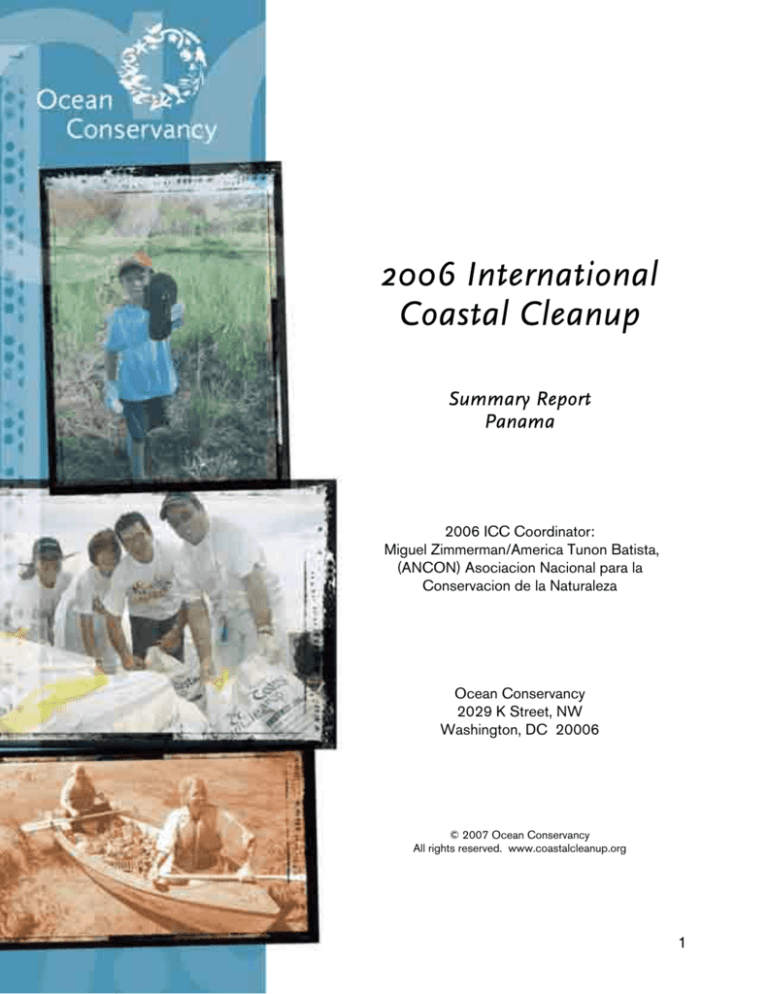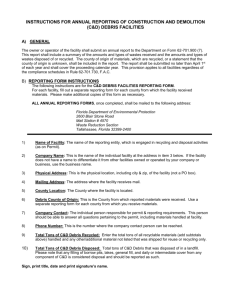
2006 International
Coastal Cleanup
Summary Report
Panama
2006 ICC Coordinator:
Miguel Zimmerman/America Tunon Batista,
(ANCON) Asociacion Nacional para la
Conservacion de la Naturaleza
Ocean Conservancy
2029 K Street, NW
Washington, DC 20006
© 2007 Ocean Conservancy
All rights reserved. www.coastalcleanup.org
Ocean Conservancy
1
The International Coastal Cleanup
The International Coastal Cleanup engages people to remove trash and debris from the world’s
beaches and waterways, to identify the sources of debris, and to change the behaviors that cause
pollution.
The 2006 ICC:
A Monumental Year
In the fight against marine debris, 2006
was a monumental year. More than
350,000 volunteers participated in the
International Coastal Cleanup (ICC)
worldwide. Participants scoured nearly
35,000 miles of shoreline and removed
some seven million pounds of trash. That’s
an average of more than 19 pounds per
person. Led by Project AWARE, more than
7,300 divers removed more than 227,000
pounds of debris from 3,100 miles of
underwater habitat – an average of more
than 31 pounds per diver.
Five countries – Bangladesh, China, El
Salvador, Iran, and Ireland – joined the
ICC’s efforts in 2006. Several other
countries saw an increase in participation:
Egypt increased volunteer numbers by 53
percent, Thailand saw a 65 percent
increase, and Venezuela’s volunteer
numbers nearly doubled.
In addition, the U.S. Congress passed the
Marine Debris Research, Prevention, and
Reduction Act, which establishes a
program within the National Oceanic and
Atmospheric Administration (NOAA) to
identify, assess, reduce, and prevent marine
debris and its effects on the marine
environment. The Act also directs NOAA to
reestablish the Interagency Marine Debris
Coordinating Committee (IMDCC). Cochaired by NOAA and the U.S.
Environmental Protection Agency. The
IMDCC works with the U.S. Coast Guard
to establish a definition of marine debris,
develop a federal marine debris information
clearinghouse, emphasize the importance
of outreach and education, and work with
the international community to address
marine debris on a global scale.
Internationally,
the
United
Nations
Environment
Programme
(UNEP)
–
Regional Seas Programme and the Global
Programme for Action (GPA) for the
Protection of the Marine Environment from
Land-based Activities developed and
implemented a number of activities on the
management of marine litter, including a
series of regional actions in several
Regional Seas Conventions. The “Global
Framework for Marine Litter Reduction” is
in development through a partnership
between the UNEP – Regional Seas
Programme and GPA and also participates
in the annual ICC.
Ocean Conservancy
2
2006 ICC: Panama
In Panama, 6,087 volunteers participated in
the ICC, removing 86,257 pounds of trash
and debris from 34 miles of shoreline. In
addition, 35 volunteers participated in
underwater cleanups, removing 410
pounds of debris from 501 miles of
riverbed and sea floor.
Land-based activities – such as picnics,
festivals, sports, and days at the beach –
accounted for 86.1 percent of the debris
found in Panama. Litter washed from
streets, parking lots, and storm drains also
contributed to this category of debris.
Worldwide, these activities represented
more than 60 percent of collected debris.
Panama: Marine Debris
Sources of Marine Debris
SmokingRelated
Activities
2.5%
Dumping
Activities
2.4%
Ocean &
Waterway
Activities
7.6%
Shoreline
&
Recreation
Activities
86.1%
In
2006,
land-based
activities
accounted for 86.1 percent of the
debris items collected in Panama.
Debris items from ocean- and waterwaybased activities – activities that originate
offshore – accounted for 7.6 percent of the
debris found in Panama. Globally, less than
seven percent of collected debris came
from ocean- and waterway-based activities.
Smoking-related activities – including
cigarette filters, cigar tips, and tobacco
packaging – accounted for 2.5 percent of
the debris found in Panama. Worldwide,
debris from smoking-related activities
comprised 29.2 percent of the collected
debris.
Each year, Ocean Conservancy compiles a
list of the “Top Ten” debris items found by
volunteers. In 2006, the items found in the
Top Ten accounted for 81.4 percent of all
the debris found in Panama.
Ocean Conservancy
Medical &
Personal
Hygiene
1.4%
Top Ten Debris Items
Debris Items
1. Beverage Bottles
(Plastic)
2. Six-Pack Holders
3. Bags
4. Beverage Cans
5. Clothing/Shoes
6. Cups, Plates And
Utensils
7. Caps/Lids
8. Food Wrappers and
Containers
9. Beverage Bottles
(Glass)
10. Bleach/Cleaner
Bottles
Totals
Amount
17,827
Percent of
Total
16.7%
17,740
11,543
8,225
7,539
6,287
16.6%
10.8%
7.7%
7.0%
5.9%
5,356
5,190
5.0%
4.9%
4,874
4.6%
2,543
2.4%
106,971
81.4%
3
Dangers of Marine Debris
Each year, ICC volunteers find animals
entangled in various forms of marine debris,
and the results can be deadly. Debris can
wrap around marine animals, hampering
mobility
and
causing
lethal
cuts,
suffocation, and even drowning. When
animals mistake debris for food, ingestion
can lead to choking and or starvation.
In 2006, ICC volunteers found 1,074
animals entangled in debris worldwide.
Discarded fishing line and nets were the
top debris items involved in entanglement.
While marine mammal entanglements may
be the most well known, they comprise only
17 percent of all recorded entanglements.
At 38 percent, seabirds accounted for the
majority of entangled creatures, proving
that marine debris also affects those
Ocean Conservancy
species that spend less time in and on the
water.
Conclusion
While marine debris continues to be a
problem, both globally and locally, efforts
such as the ICC indicate that people are
willing to take steps to address the issue. In
addition to cleaning up existing debris,
success is dependent upon pinpointing the
types of activities that cause debris and
creating educational programs to help
people develop a new mindset toward
littering. Inspiring this course of change and
encouraging people to become good
ocean stewards is one of – if not the most
– important components of the ICC’s
mission.
4
What You Can Do
1) Join the Ocean Conservancy’s
International Coastal Cleanup.
2) Clean up your trash, even when not
near the water. It’s amazing that a vast
majority of trash in our waterways comes
from land-based activities. Even trash
discarded miles inland can make it to the
ocean, washed there by the rain and the
winds.
3) Retrieve your monofilament fishing
line. Don’t leave fishing line in the water
and remove others’ when you find it…being
careful not to tug on snagged lines that
could be caught on important things below
the surface.
4) Contain and properly clean spills when boating. Use oil-absorbent rags or even
diapers to clean spills. The Ocean Conservancy’s Good Mate program can provide you
with plenty of tips for reducing your impact when on the water.
5) Recycle used motor oil and oil filters. Your local gas station should have facilities
for recycling these materials. Never pour oil, paint, antifreeze, or other household
chemicals into an open sewer.
6) Find alternatives to household chemicals. Don’t use fertilizers, pesticides, and
herbicides that can wash into open waters. Use lemon juice, vinegar, and baking soda
for household cleaning.
7) Become a storm drain sentry. Stencil your local drains to remind people where the
things they dump there end up…and of the potential consequences.
8) Use cloth bags for groceries. Take them with you when you shop to reduce the
number of plastic bags you use. In addition to being unsightly, discarded plastic bags
can choke marine wildlife when mistaken for food.
9) Properly dispose of used batteries and electronics. Use your local recycling
center. Electronics leach harmful chemicals into the environment. Once there, these
toxic pollutants can take a long time to go away.
10) Contact your elected representatives. Let them know you care
about marine debris and that you are watching what they do to stop it. Then, vote for
candidates who support marine debris prevention.
Ocean Conservancy
5
ICC 2006 Donors
The Coca-Cola Company
National Oceanic and Atmospheric Administration
Bank of America
U.S. Environmental Protection Agency
Brunswick Public Foundation
The Dow Chemical Company
ITW Hi-Cone
ICC 2006 Panama Sponsors
THE SHELL COMPANY LTD PANAMA
REFRESCOS NACIONALES, S.A.
FRANQUICIAS PANAMEÑAS
SYNGENTA, S.A.
HOTEL INTERCONTINENTAL MIRAMAR PANAMA
POLYMER
BONLAC, S.A.
ALCADIA DE PANAMA
PRODUCTOS ALIMENTICIOS PASCUAL, S.A.
KOMEX INTERNATIONAL (TANDOR COMERCIAL, S.A.)
INDUSTRIAS LACTEAS, S.A.
DEL PRADO, CONSERVAS PANAMEÑAS SELECTAS, S.A.
SERVICIOS DE EMERGENCIAS MEDICAS MOVILES (SEMM)
SAFE T. SUPPLY, S.A.
INSTITUTO PANAMEÑO DE TURISMO
COCA COLA FEMSA
HIELO FIESTA, S.A.
AGUAS CRISTALINAS, S.A.
PANAPATTY, S.A.
DARSEG, S.A.
SUGAVEL, S.A.
CERVECERIA BARU PANAMA
MANZANILLO INTERNATIONAL TERMINAL
COOPEDUC
PLASTIGOL.SA
COOPERATIVA DE AHORROS Y CREDITOS (AUXILIARES DE ENFERMERIA
Y AFINES)
Ocean Conservancy
6
Debris items collected during the 2006 ICC in Panama
DEBRIS ITEMS
Shoreline and Recreational Activities
Bags
Balloons
Beverage Bottles (plastic) 2 liter or less
Beverage Bottles (glass)
Beverage Cans
Caps/Lids
Clothing/Shoes
Cups, plates, etc
Food Wrappers
Pull Tabs
Six-Pack Holders
Shotgun Shells
Straws/Stirrers
Toys
Ocean and Waterway Activities
Bait Containers
Bleach/Cleaner
Buoys/Floats
Crab/Lobster/Fish Traps
Crates
Fishing Line
Fishing Lures/Light Sticks
Fishing Nets
Light Bulbs
Oil/Lube Bottles
Pallets
Plastic Sheeting
Rope
Strapping Bands
Smoking-Related Activities
Cigarettes/Cigarette Filters
Cigarette Lighters
Cigar Tips
Tobacco Packaging
Dumping Activities
Appliances
Batteries
Building Materials
Car/Car Parts
55-Gallon Drums
Tires
Medical and Personal Hygiene
Condoms
Diapers
Syringes
Tampons
Totals
Ocean Conservancy
LAND
UNDERWATER
TOTAL
11,529
2,083
17,806
4,865
8,181
5,351
7,523
6,268
5,182
1,662
17,735
145
1,370
2,279
14
2
21
9
44
5
16
19
8
2
5
0
0
8
11,543
2,085
17,827
4,874
8,225
5,356
7,539
6,287
5,190
1,664
17,740
145
1,370
2,287
92
2,534
446
64
140
68
79
451
458
2,046
162
655
738
184
0
9
0
0
0
0
0
0
1
8
0
3
6
2
92
2,543
446
64
140
68
79
451
459
2,054
162
658
744
186
1,746
278
156
484
0
2
0
1
1,746
280
156
485
150
599
793
604
71
324
0
4
4
0
0
1
150
603
797
604
71
325
442
681
175
172
106,771
0
2
0
4
200
442
683
175
176
106,971
7
Panama 2006 ICC – Sources of Marine Debris – Land and Underwater Cleanups
SmokingRelated
Activities
2.5%
Dumping
Activities
2.4%
Medical &
Personal
Hygiene
1.4%
SmokingRelated
Activities
1.5%
Ocean &
Waterway
Activities
7.6%
Dumping
Activities
4.5%
Medical &
Personal
Hygiene
3.0%
Ocean &
Waterway
Activities
14.5%
Shoreline
&
Recreation
Activities
76.5%
Shoreline
&
Recreation
Activities
86.1%
Land Cleanups
Underwater Cleanups
Panama 2006 ICC “Top Ten” Debris Items – Land and Underwater Cleanups
Land Cleanups Only
Debris Items
1. Beverage Bottles
(Plastic)
2. Six-Pack Holders
3. Bags
4. Beverage Cans
5. Clothing/Shoes
6. Cups, Plates And
Utensils
7. Caps/Lids
8. Food Wrappers and
Containers
9. Beverage Bottles
(Glass)
10. Bleach/Cleaner
Bottles
Totals
Ocean Conservancy
Underwater Cleanups Only
Amount
17,806
Percent of
Total
16.7%
17,735
11,529
8,181
7,523
6,268
16.6%
10.8%
7.7%
7.0%
5.9%
5,351
5,182
5.0%
4.9%
4,865
4.6%
2,534
2.4%
106,771
81.5%
Debris Items
1. Beverage Cans
2. Beverage Bottles (Plastic)
3. Cups, Plates And Utensils
4. Clothing/Shoes
5. Bags
6. Bleach/Cleaner Bottles
7. Beverage Bottles (Glass)
8. Food Wrappers and
Containers
9. Oil/Lube Bottles
10. Toys
Totals
Amount
44
21
19
16
14
9
9
8
8
8
200
Percent of Total
22.0%
10.5%
9.5%
8.0%
7.0%
4.5%
4.5%
4.0%
4.0%
4.0%
78.0%
8







